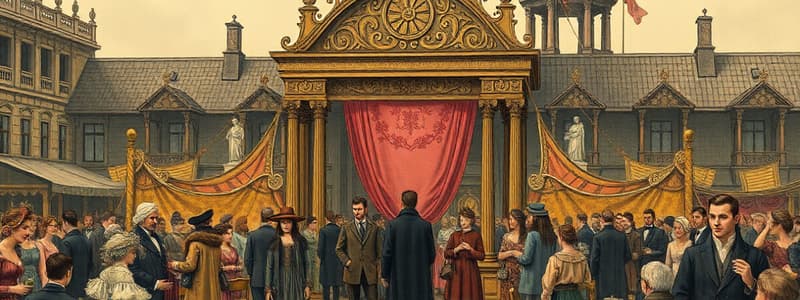Podcast
Questions and Answers
What does MICE stand for?
What does MICE stand for?
- Meetings, International, Conventions, Exhibitions
- Meetings, Incentives, Conventions, Events
- Meetings, Incentives, Conferences, Exhibitions
- Meetings, Incentives, Conventions, Exhibitions (correct)
What are exhibitions typically focused on?
What are exhibitions typically focused on?
Promoting key products and services to the public.
The first convention bureau in the United States was established in the 20th century.
The first convention bureau in the United States was established in the 20th century.
False (B)
Events are a unique blend of management, programming, setting, and _____
Events are a unique blend of management, programming, setting, and _____
Which of the following is NOT a key trend in MICE?
Which of the following is NOT a key trend in MICE?
What kind of organizations typically serve as clients in MICE?
What kind of organizations typically serve as clients in MICE?
Conventions started gaining popularity in the United States after the 1950s.
Conventions started gaining popularity in the United States after the 1950s.
Meetings are typically held in hotel conference rooms or at _____
Meetings are typically held in hotel conference rooms or at _____
Match the following key players of MICE with their descriptions:
Match the following key players of MICE with their descriptions:
Flashcards are hidden until you start studying
Study Notes
Definition of Events
- Organized occasions include meetings, conventions, exhibitions, and special events such as gala dinners.
- Events gather people in one location to confer or execute a specific activity.
- Unique blend of management, programming, setting, and attendees defines events.
- Events are transient and temporary in nature.
- Typically, events are publicized and have fixed dates.
Historical Overview
- Early communal discussions focused on interests like hunting and war among primitive communities.
- Significant meeting places included the Roman Forum and Comitium in Rome.
- The Congress of Vienna (1814-15) marked the inception of conventions in Europe.
- Detroit established the first U.S. convention bureau in 1896 to manage and promote conventions.
- Incentive travel programs began with the National Cash Register (NCR) in 1902, enhancing corporate practices.
- The conventions industry emerged in the 1950s due to:
- Expansion of government organizations and multinational corporations.
- Growth in association interests and professional groups.
- Evolution of sales techniques, engaging product launches and training meetings.
- Specialization in conference topics facilitating information sharing.
Capacity of Key Venues
- Sheffield Arena: 12,000 capacity.
- National Arena Birmingham: 13,000 capacity.
- Wales Millennium Centre: 19,000 capacity.
- PICC: 3,500 capacity.
Global MICE Landscape
- Europe and North America lead in the convention and exhibition market by event numbers.
- Asia's convention industry has experienced significant growth since the 1960s, despite limited activity until the 1950s due to World Wars.
Overview of MICE
- MICE stands for Meetings, Incentives, Conventions, and Exhibitions, a sector of tourism focusing on business events.
- Meetings are typically short, single-day gatherings in hotel conference rooms or convention centers aimed at addressing challenges or organizational goals.
- Incentives are travel rewards from companies to employees or groups for excellent performance, boosting employee loyalty.
- Conferences entailing several days of knowledge sharing often include guest speakers and broader audiences.
- Exhibitions or trade shows are events for organizations to promote their products and services, emphasizing business generation and networking opportunities.
Key Trends in MICE
- Sustainability: Growing focus on environmentally friendly practices.
- Personalization: Tailoring experiences to meet individual preferences.
- Technology: Integration of tech tools to enhance event experiences.
- Catering: Demand for specialized food and beverage experiences.
Components of MICE
-
Clients (Planners): Decision-makers organizing activities, including:
- Associations: Non-profit professional or industry organizations.
- Corporations: Business organizations facilitating their own events.
- Event Planners: Professionals hired to manage and plan business activities.
-
Suppliers: Organizations providing various services essential for MICE events.
Studying That Suits You
Use AI to generate personalized quizzes and flashcards to suit your learning preferences.



